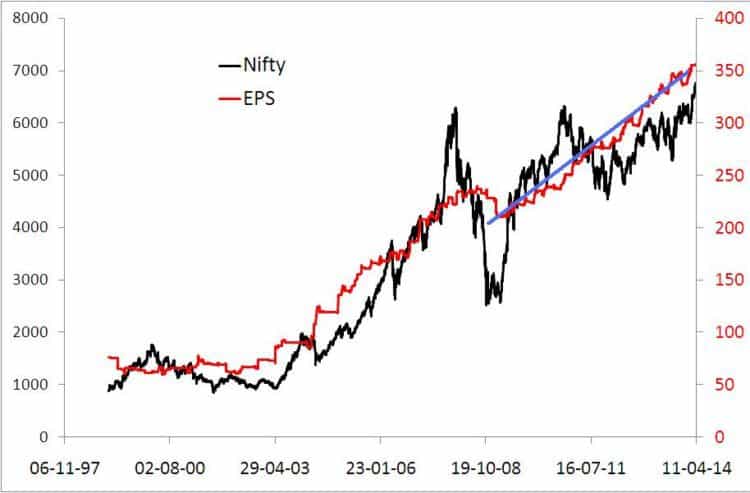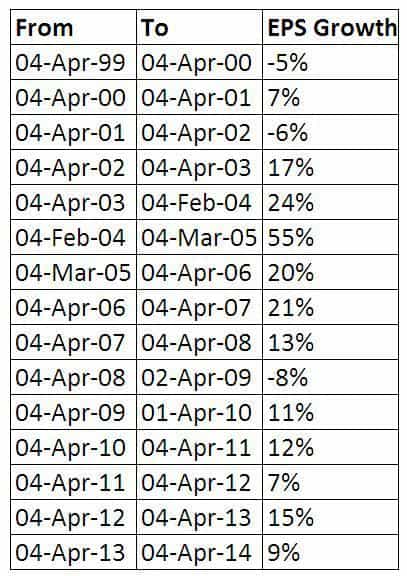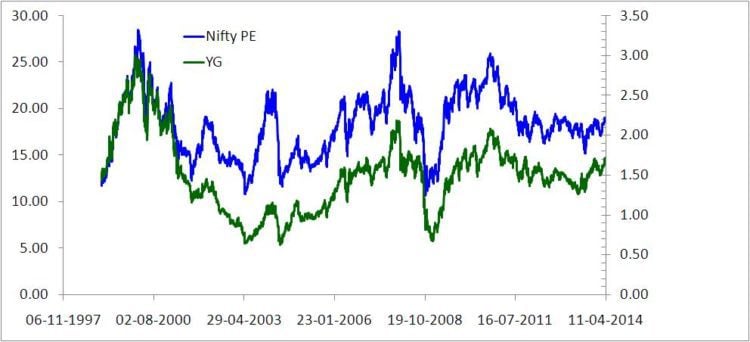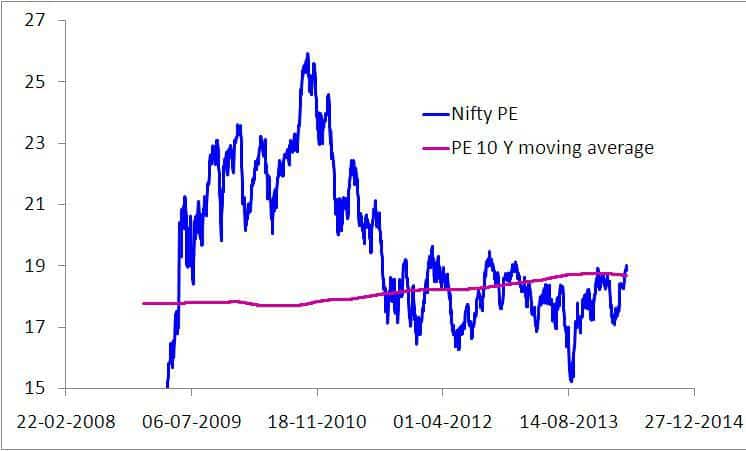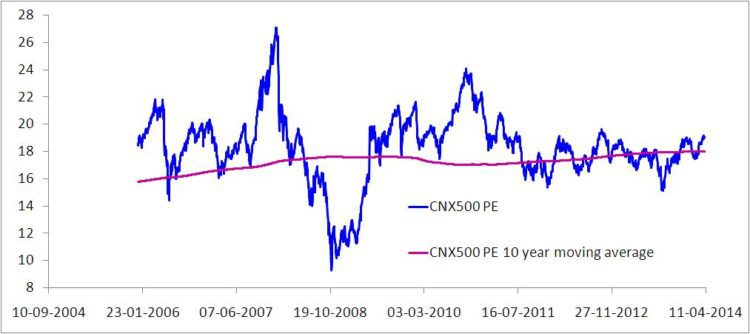Last Updated on December 18, 2021 at 10:40 pm
Are we at the start of a bull run? Will the markets tank after elections? Should we book profits now, while the going is good? Should I invest now or wait after the election results are announced?
Such questions are on everyone’s mind. While dealing with volatile instruments like equity, some amount of tactical nous is necessary after a few years of investing to preserve the fruit of compounding. So while such questions are quite pertinent do not expect quant.-based answers to be far removed from commonsense and state what you would like to hear!
While someone who has just started mutual fund investing must continue their SIPs, someone with 5-6 years of experience will have to analyse the state of the markets every time there is a significant gain or loss in their equity or debt folio and respond appropriately. Including doing nothing!
This is an attempt by an non-expert to analyse the state of the markets with available information.
Join 32,000+ readers and get free money management solutions delivered to your inbox! Subscribe to get posts via email! (Link takes you to our email sign-up form)
🔥Want to create a complete financial plan? Learn goal-based investing? Exclusive access to our DIY tools? Increase your income with your skills? Enjoy massive discounts on our robo-advisory tool & courses! 🔥
Nifty vs. Nifty Earnings Per Share
Using the definition of the price-to-earning ratio,
PE = Market Price per Share / Earnings per Share
We can calculate the Nifty Earnings per share from the Nifty closing value and Nifty PE. This is a crude estimate without considering the individual EPS values of the constituents.
Notice the rather smooth increase in EPS when observed over a long period.
From about 2003 to the present, with the exception of the 2008 crisis, the EPS has increased approximately linearly. In the region covered by the blue line, the rate of growth has been 12%.
This can be thought of as the ‘historical’ long term returns from equity. Expecting more than this from your equity mutual funds is not a smart idea.
Of course the annual EPS growth (annual percentage change) fluctuates quite a bit.
Clear from the table that in the recent past, EPS growth is a far cry from the bull run seen in the 2000s
Plotting the EPS using Nifty and Nifty PE tells us that the market is rewarding long term investor at a consistent rate regardless of short term instability and sideways movement. So whether you adopt tactical asset allocation or believe in averaging market movements with a SIP, you will be able to beat inflation.
Nifty vs. Nifty PE
With that piece of (obvious!) gyan behind us, let us look at the Nifty vs the Nifty PE.
The long term Nifty PE movement is about 45-50% correlated with the Nifty. In the last year, this correlation is as high as 86%!
So looking at the Nifty PE alone can provide us decent insight into the state of the stock market.
Notice that the Nifty PE has remained relatively flat recently while the index has moved up. This means that the despite the recent rally the marker is neither undervalued or overvalued.
Nifty PE vs. Nifty EPS Growth (rolling annual % gain)
The EPS growth reflects the flat nifty suggesting that the present gains in the index is not part of a rally as historically, rallies have been accompanied with a sharp rise in EPS growth.
So just because markets have improved for a month, removing capital now from your holdings in the name of booking profit is not a smart idea. If one must shift some gains that it has to be backed by solid logic.
Continuing SIPs is always a smart idea! (don’t need the graphs to establish that!)
If you have a lump sum to invest, should you do invest now or after the elections?
My view is, if there is not a single majority (a strong possibility because of the state politics), the markets would tank yes, but only temporarily. Even with a coalition govt, I expect the markets to rally in a few months time.
If there is a strong majority, the markets might soar but then in a few months time, normalcy would return.
Therefore, for lump sum investments, now or a couple of months later would not make a big difference over the long term.
If you have been investing for a while and if your portfolio has become lopsided by more than 5% because of the gains in equity, it would make sense to shift some of it to debt. Only some of it. Keeping in mind the tenure of the goal and its asset allocation.
This kind of profit booking is known by a more ‘decent’ name – rebalancing! If you wish to know more about this, suggest you start here.
At the end of the day, market movements are largely based on sentiments and hunches. When elections were announced, the markets reacted to the possibility of a strong govt but at the same time seems to be worried considering the different political equations at play.
The best quantitative indicator of ‘market sentiment’ is the Nifty Volatility index: India VIX
India VIX vs. Nifty PE
Notice that India VIX has risen much more sharply than the Nifty PE in last month or so. That is the market is expected to be volatile in the next 30 days. So do not expect too much of a rally in this period.
Meanwhile, the 10-Year G-sec rates have increased! From 8.812% on Mar. 9th 2014 to 9.104% on April 7th 2014.
Correspondingly the 1-year G-sec rates have decreased. From 8.913% on Mar. 9th 2014 to 8.654% on April 7th 2014.
Thus the difference between 10-Y and 1-Y debt securities has widened.
The value of a bond has an inverse relationship with interest rate. If long term interest rates increase, the value of a bond has to fall in order to match current yields. The NAV of a bond fund holding such long term bonds will decrease
Similarly if long term interest rates decrease, the value of a bond increases to match current yield levels and the NAV of the bond fund increases.
So when long term rates increase, debt funds with maturity duration much lower than 10 years is preferred and vice-versa.
Analogously, when 1Y rates decrease, debt funds with maturity duration higher than 1 year is preferred
Well, all this means is that in the current interest rate scenario, for long term goals, one can invest in debt fund with maturity values higher than 1 year but much lower than 10 years.
Unfortunately, that is stating the obvious! This is an all weather recommendation for long term goals!
However, this does not mean equity is overvalued or unfavorable.
Tactical asset allocation: Yield-Gap vs PE
Tactical asset allocation refer to the method in which the asset allocation of a portfolio is changed rather dramatically in line with stock and debt market conditions.
This can be done in several ways.
Tactical asset allocation incorporates an element of market timing by determining which market is more favourable.
P/E model the value of stocks are evaluated with their price to earnings ratio. High PE (>22) exit equity in phases. Low PE (~ <15) buy equity in phases
As mentioned above, according to the ‘PE model’, the market is neither overvalued or undervalued. So the ‘signal’ is stay put.
Yield Gap Model Instead of looking at only the stock market, the price of the equity index is evaluated with respect to the debt index.
Defining Yield Gap like the DSP BR Asset allocation fund,
Yield gap = (10 year Govt. Securities yield) X (P/E Nifty index ratio)
The Yield Gap was 1.62 on 9th March 2014 and has increased to 1.72 on 7th April,
The 10 year G-sec rates are primarily responsible for this increase since the Nifty PE has more or less remained constant in this period.
So if you take this increase in yield gap ratio seriously, you ought to decrease equity holding by a good 10-20% and shift to debt (see asset allocation strategy of the DSP BR fund)
Not sure if this is a smart thing to do when the Nifty PE has remained flat in that period and close to its long-term average.
If you see the 10 year moving average of the Nifty PE, you will see that we are still quite close to the average. This is true for also the 15 year average ~ 18.3.
So there is no need to tinker with the equity folio, unless it has shifted by more than 5% of the intended asset allocation.
The yield gap model is too conservative compared to the PE model and I think is unsuitable for young investors who ought to be aggressive. I think it should be used only in conjunction with the PE model.
Perhaps what one can do is to increase investments in debt funds mentioned above, without tinkering with existing equity holdings.
So let us summarize:
New to mf investing: stay invested.
Goal less than 5 years away: Book some profit and prepare an exit strategy.
Goal more than 5 years away: Rebalance if equity portfolio has increased by 5% or so, or if your folio is not balanced in the first place!
Not investing with a goal in mind: find one first! The state of the markets can wait!
Feel free to leave a comment if you need the Excel data files for any of the plots in this post/blog.
Postscript In response to Deepak’s comment below, here is the CNX 500 PE vs 10 PE moving average. Although the CNX 500 appears to be a bit more overvalued than the Nifty, I don’t think it is high enough to exit equities. It does require a close watch though.
🔥Enjoy massive discounts on our courses, robo-advisory tool and exclusive investor circle! 🔥& join our community of 7000+ users!
Use our Robo-advisory Tool for a start-to-finish financial plan! ⇐ More than 2,500 investors and advisors use this!
Track your mutual funds and stock investments with this Google Sheet!
We also publish monthly equity mutual funds, debt and hybrid mutual funds, index funds and ETF screeners and momentum, low-volatility stock screeners.





- Do you have a comment about the above article? Reach out to us on Twitter: @freefincal or @pattufreefincal
- Have a question? Subscribe to our newsletter using the form below.
- Hit 'reply' to any email from us! We do not offer personalized investment advice. We can write a detailed article without mentioning your name if you have a generic question.
Join 32,000+ readers and get free money management solutions delivered to your inbox! Subscribe to get posts via email! (Link takes you to our email sign-up form)
About The Author
 Dr M. Pattabiraman(PhD) is the founder, managing editor and primary author of freefincal. He is an associate professor at the Indian Institute of Technology, Madras. He has over ten years of experience publishing news analysis, research and financial product development. Connect with him via Twitter(X), Linkedin, or YouTube. Pattabiraman has co-authored three print books: (1) You can be rich too with goal-based investing (CNBC TV18) for DIY investors. (2) Gamechanger for young earners. (3) Chinchu Gets a Superpower! for kids. He has also written seven other free e-books on various money management topics. He is a patron and co-founder of “Fee-only India,” an organisation promoting unbiased, commission-free investment advice.
Dr M. Pattabiraman(PhD) is the founder, managing editor and primary author of freefincal. He is an associate professor at the Indian Institute of Technology, Madras. He has over ten years of experience publishing news analysis, research and financial product development. Connect with him via Twitter(X), Linkedin, or YouTube. Pattabiraman has co-authored three print books: (1) You can be rich too with goal-based investing (CNBC TV18) for DIY investors. (2) Gamechanger for young earners. (3) Chinchu Gets a Superpower! for kids. He has also written seven other free e-books on various money management topics. He is a patron and co-founder of “Fee-only India,” an organisation promoting unbiased, commission-free investment advice.Our flagship course! Learn to manage your portfolio like a pro to achieve your goals regardless of market conditions! ⇐ More than 3,000 investors and advisors are part of our exclusive community! Get clarity on how to plan for your goals and achieve the necessary corpus no matter the market condition is!! Watch the first lecture for free! One-time payment! No recurring fees! Life-long access to videos! Reduce fear, uncertainty and doubt while investing! Learn how to plan for your goals before and after retirement with confidence.
Our new course! Increase your income by getting people to pay for your skills! ⇐ More than 700 salaried employees, entrepreneurs and financial advisors are part of our exclusive community! Learn how to get people to pay for your skills! Whether you are a professional or small business owner who wants more clients via online visibility or a salaried person wanting a side income or passive income, we will show you how to achieve this by showcasing your skills and building a community that trusts and pays you! (watch 1st lecture for free). One-time payment! No recurring fees! Life-long access to videos!
Our new book for kids: “Chinchu Gets a Superpower!” is now available!


Must-read book even for adults! This is something that every parent should teach their kids right from their young age. The importance of money management and decision making based on their wants and needs. Very nicely written in simple terms. - Arun.Buy the book: Chinchu gets a superpower for your child!
How to profit from content writing: Our new ebook is for those interested in getting side income via content writing. It is available at a 50% discount for Rs. 500 only!
Do you want to check if the market is overvalued or undervalued? Use our market valuation tool (it will work with any index!), or get the Tactical Buy/Sell timing tool!
We publish monthly mutual fund screeners and momentum, low-volatility stock screeners.
About freefincal & its content policy. Freefincal is a News Media Organization dedicated to providing original analysis, reports, reviews and insights on mutual funds, stocks, investing, retirement and personal finance developments. We do so without conflict of interest and bias. Follow us on Google News. Freefincal serves more than three million readers a year (5 million page views) with articles based only on factual information and detailed analysis by its authors. All statements made will be verified with credible and knowledgeable sources before publication. Freefincal does not publish paid articles, promotions, PR, satire or opinions without data. All opinions will be inferences backed by verifiable, reproducible evidence/data. Contact information: To get in touch, use this contact form. (Sponsored posts or paid collaborations will not be entertained.)
Connect with us on social media
- Twitter @freefincal
- Subscribe to our YouTube Videos
- Posts feed via Feedburner.
Our publications
You Can Be Rich Too with Goal-Based Investing
 Published by CNBC TV18, this book is meant to help you ask the right questions and seek the correct answers, and since it comes with nine online calculators, you can also create custom solutions for your lifestyle! Get it now.
Published by CNBC TV18, this book is meant to help you ask the right questions and seek the correct answers, and since it comes with nine online calculators, you can also create custom solutions for your lifestyle! Get it now.Gamechanger: Forget Startups, Join Corporate & Still Live the Rich Life You Want
 This book is meant for young earners to get their basics right from day one! It will also help you travel to exotic places at a low cost! Get it or gift it to a young earner.
This book is meant for young earners to get their basics right from day one! It will also help you travel to exotic places at a low cost! Get it or gift it to a young earner.Your Ultimate Guide to Travel
 This is an in-depth dive into vacation planning, finding cheap flights, budget accommodation, what to do when travelling, and how travelling slowly is better financially and psychologically, with links to the web pages and hand-holding at every step. Get the pdf for Rs 300 (instant download)
This is an in-depth dive into vacation planning, finding cheap flights, budget accommodation, what to do when travelling, and how travelling slowly is better financially and psychologically, with links to the web pages and hand-holding at every step. Get the pdf for Rs 300 (instant download)